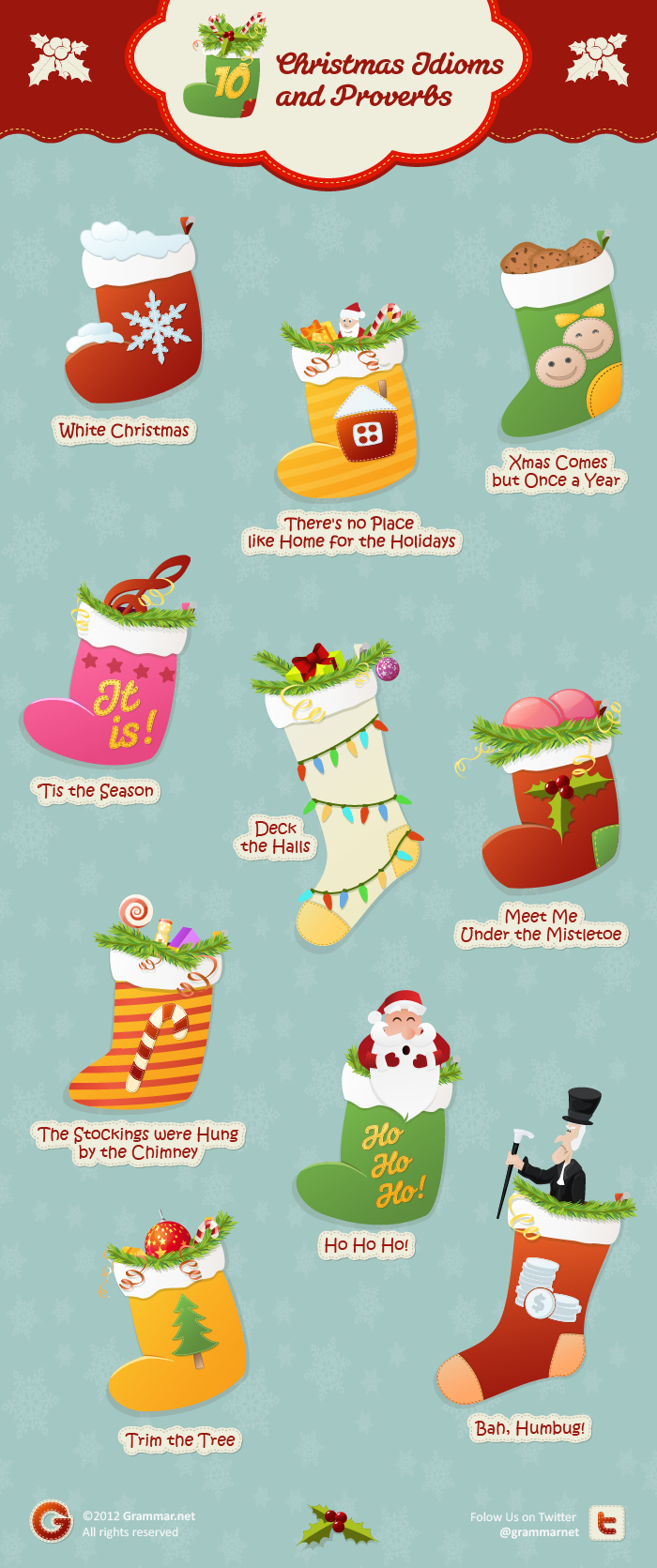What are Idioms?
An idiom is a phrase in which the meaning has little or nothing to do with the literal wording. Examples of idioms in general speech are “raining cats and dogs” and “keep an eye out.” The first indicates a heavy downpour of rain, while the second means to keep watch for something.
Embed this image to your site:
To download high-resolution poster click here
Holiday Idioms and Phrases
White Christmas
The prettiest holiday, according to most, is one where it has snowed. This wish for white was celebrated many years ago in a popular song, and the title of this carol is now a traditional holiday phrase.
There’s no Place like Home for the Holidays
Another favorite carol came out of the sentiment that the best place to celebrate the holidays is with the family. College students return to their parents’ home, and extended families descend on a pre-planned relative for festive celebration and gift-giving.
Xmas Comes but Once a Year
Recently, this has become an excuse for gorging on holiday cookies or spending too much on presents, but this proverb quietly states that people need to be kind to each other year-round rather than just during the holidays.
‘Tis the Season
“‘Tis” is an old method of contracting “it” and “is.” Today, it is rarely used in anything but traditional song or poetry, such as “My Country ‘Tis of Thee,” or “‘Tis better to have loved and lost than never to have loved at all,” by Alfred Lord Tennyson. This usage is abbreviated from a line in a holiday carol: “‘Tis the season to be jolly.” The word “jolly” is also old and simply means “happy.”
Deck the Halls
“Decking” or decorating the halls with branches from a holly tree is an old tradition, and the popular carol began as a Welsh tune from the 1700s. These days, merry-makers deck their halls with blinking lights, pine branches, popcorn strung on strands of thread, and glittery garland.
Meet Me Under the Mistletoe
European mistletoe is a shrub with yellow flowers and white, poisonous berries. The tradition of kissing under a hanging sprig of this plant began in 16th century England, but it was not connected to holiday tradition until the 18th century. In 1820, American author Washington Irving wrote, “–the young men have the privilege of kissing the girls under it, plucking each time a berry from the bush. When the berries are all plucked the privilege ceases.”
The Stockings were Hung by the Chimney
The actual origin is uncertain, but hundreds of years ago, children dried damp socks by hanging them overnight from the fireplace mantle. At some point, a benevolent stranger, saint, or parent slipped some gifts into these stockings, and it is now an inseparable tradition. Holiday stockings are filled with small presents and fruit, such as apples and oranges, though naughty children may receive only a chunk of coal.
Ho Ho Ho!
The tradition involves a fat, bearded man in a red suit slipping through chimneys to leave presents for the children, and “ho ho ho” is an imitation of the old fellow’s laughter. One must hold his belly with both hands while imitating, and jolliness is mandatory.
Bah, Humbug!
On the other hand, “Bah, humbug!” is the derisive, holiday-hating rant of Ebenezer Scrooge from Charles Dickens’ 1843 novella, “A Christmas Carol.” Today, folks will often shout this at each other, jokingly (or bitterly), when confronted with holiday well-wishers.
Trim the Tree
This is an old reference to decorating a pine tree with ornaments, lights, and whatever glittery bits strike a family’s fancy.



![Using Present Tense to Tell About the Past [infographic]](https://www.grammar.net/wp-content/uploads/2012/12/present-as-past_small-308x95.png)
![New Words of 2012 [infographic]](https://www.grammar.net/wp-content/uploads/2013/01/12-new-words_small-308x95.png)


